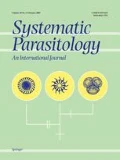Summary
The genus Ornithocheyletia Volgin, 1964 is revised. If the three species described below are included the number of known species in this genus is now 22. These species live on or in the skin of birds and produce mange. The holotypes of all these species have been examined except those of O. pinguis (Berlese) and of O. dubinini Volgin which were not available. Three new species and one new subspecies are described: O. geopeliae sp. nov. from Geopelia striata, O. lepidus sp. nov. from Garrulax leucolophus bicolor, O. eulabes from Eulabes javana and O. psittaci poicephali ssp. nov. from Poicephalus senegalus. O. similis Fain, 1972 is placed as a subspecies of O. hallae Smiley, 1970. The genus Ornithocheyletia is redefined and a key to the species is provided. The following stages have been observed in the life cycle: egg—prelarva—larva— protonymph—tritonymph—adults. A prelarva is observed for the first time: it is represented by a small ecdysis organ consisting of two small bifid sclerites serving for the rupture of the eggshell. The adult female develops into a tritonymph, the adult male into a protonymph. The males are either homeomorphic or heteromorphic; the latter are characterized by the hypertrophy and modification of the gnathosoma, especially the palps. ac]19800531
Similar content being viewed by others
References
Baker, E.W. (1949) A review of the mites of the family Cheyletidae in the United States National Museum. Proceedings of the United States National Museum, 99, 267–232.
Banks, N. (1909) New Canadian Mites. Proceedings of the Entomological Society of Washington, 7, 133–142.
Berlese, A. (1889) Acari, Myriapoda et Scorpiones hucusque in Italia reperta. Portici et Padua, 56, 3–4.
Fain, A. (1972) Notes sur les Acariens des familles Cheyletidae et Harpyrhchidae producteurs de gale chez le Oiseaux ou les Mammiferes. Acta Zoologica et Pathologica Antverpiensia, 56, 37–60.
Fain, A. (1979) Idiosomal and leg chaetotaxy in the Cheyletidae. International Journal of Acarology, 5, 305–310.
Oudemans, A.C. (1906) Revision des Cheyletines. Mémoires de la Société Zoologique de France 19, 36–218 (figs. 1–66).
Smiley, R.L. (1970) A review of the family Cheyletiellidae (Acarina). Annals of the Entomological Society of America, 63, 1056–1078.
Smiley, R.L. (1977) Further studies on the family Cheyletiellidae (Acarina). Acarologia, 19, 225–241.
Summers, F.M. & Price, D.W. (1970) Review of the family Cheyletidae. University of California Publications in Entomology, Vol. 61, 1–153.
Volgin, V.I. (1964) [On the taxonomy of predatory mites of the family Cheyletidae VI. The genus Ornithocheyletia Volgin gen. nov.] Zoologischeskii Zhurnal, 43, 28–36 (In Russian).
Volgin, V.I. (1969) [Acarina of the family Cheyletidae, World Fauna—Akademia Nauk S.S.S.R.—Opredeliteli Po Faune SSSR—Zoologicheskii Institut, No. 101, 1–432 (Figs. 1–533) (In Russian).
Womersley, H. (1941) Notes on the Cheyletidae (Acarina, Trombidoidea) of Australia and New Zealand, with descriptions of new species. Records of the South Australian Museum, 7, 51–64.
Author information
Authors and Affiliations
Rights and permissions
About this article
Cite this article
Fain, A. Revision of the genus Ornithocheyletia Volgin, 1964 (Acari: Cheyletidae). Syst Parasitol 2, 181–205 (1981). https://doi.org/10.1007/BF00009531
Accepted:
Issue Date:
DOI: https://doi.org/10.1007/BF00009531



